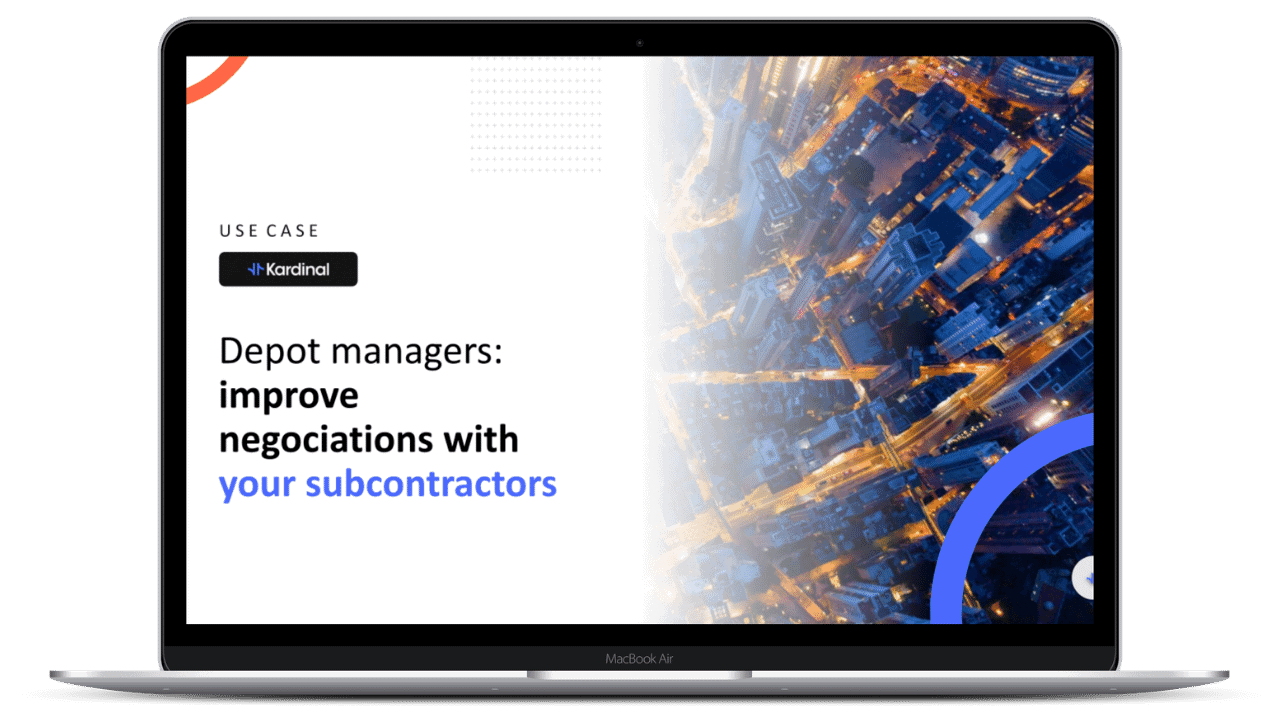For transport operators, profitability is crucial. This is even more true for those who manage the last mile of the chain (especially parcel delivery companies), known to be the most expensive and least profitable.
With the growth of e-commerce, parcel delivery companies are faced with ever-increasing volumes of packages. Their challenge is to be profitable on a large scale. In an industry that is not yet fully digitalized, couriers lack visibility into their operations. Yet, it is essential to monitor their profitability and operational performance on a regular basis in order to quickly adjust and optimize their failing depots and areas. This is the case for parcel delivery companies but also for their subcontractors whose situation is more critical. Indeed, many transport companies go bankrupt every year due to lack of profitability.
With the shortage of drivers and the increase in fuel prices, transport prices continue to rise. It is becoming urgent for parcel delivery depot managers and their subcontractors to optimize their organizations and to better negotiate their contracts in order to improve their profitability.
How can a depot manager better remunerate his subcontractors in order to guarantee their longevity while increasing his economic performance? Discover our answers in this article!
How is the cost of last mile delivery established?
In order to improve the profitability of parcel delivery companies, you must first understand how the industry works. The mission of parcel delivery companies is to transport a package from the sender to the recipient. In order to reduce delivery times and maximize their productivity, couriers rely on a very specific organization: they organize the collection of parcels, their grouping in long-distance trucks through a network of sorting facilities to the destination depot which manages the final delivery on a given territory (more or less the size of a department for France for example).
These different stages each have an impact on the cost of delivery, the most important being the last mile, which represents more than 53% of total costs. It is therefore crucial for parcel delivery companies to optimize this last link in the logistics chain. Each depot manager must ensure that productivity and profitability are maximized in his or her territory, and this, thanks to a good organization of transport operations (deliveries, pick-ups).
The parcel delivery company’s role is to organize and manage a national or even international transport network. The more complex last-mile activity is managed by smaller local companies. Parcel delivery players therefore rely heavily on subcontractors: a study conducted by Mazars and the Ile-de-France General Council in 2011 estimated that 80% of parcel delivery platforms in the Ile-de-France region subcontract this activity.
This very high cost of the last mile is provided by subcontractors but financed by the parcel delivery company. The latter is therefore looking for ways to optimize these costs in order to increase its profitability. The pricing of the subcontractor is therefore at the heart of the negotiations.
Last mile delivery: what pricing for subcontractors?
Each subcontractor is assigned a given territory, generally based on zip codes, within which it must autonomously organize its routes and deliver all packages. This territorial sectorization, done upstream, strongly conditions the depot’s cost structure since it determines the number of vehicles required and the areas covered by each subcontractor.
Market practice for paying subcontractors seems to be the “price per parcel” model. It means that the parcel delivery company’s depot manager makes a deal with the subcontractor on that “price per parcel”, then it’s up to the subcontractor to be efficient enough to make a living with that price. The income of the subcontractor can thus be very variable from one month to another according to the number of transported parcels.
This “price per package” model has two advantages for the parcel delivery company:
- Its customers (B2B shippers, e-commerce companies…) pay a service per package so this model allows to keep the same value unit.
- This model encourages providers to deliver as many packages as possible and not leave any out.
In practice, it is very complicated to negotiate a price per parcel because not all delivery areas have the same profitability. There are great disparities between a hyper-dense urban area close to the sorting facility and a remote rural area that requires more travel.
The differences between the areas to be delivered in the same depot can be very important: two routes can each require 8 hours of working time, but the one far from the depot will visit only about 40 points, while the one in the city center will visit 120. It is therefore impossible to set a single price per parcel for all subcontractors. To set the price, it is necessary to take into account the characteristics of each area.
This leads to a pricing negotiation that allows both parties to be profitable. Indeed, each one has costs inherent to its business:
- The parcel delivery company incurs costs related to long-distance transport (routing before the last mile) as well as structural costs (IT, buildings, salaries of management and operational teams). By subtracting these different costs from the total price of services sold, you get the parcel delivery company’s profitability thresholds for the last mile.
- On the other hand, the subcontractor has its own costs, some of which are structural (buildings, vehicle purchase and maintenance, administrative tasks), but most of which come from salaries and fuel. This leads to another profitability threshold, which is the minimum amount per package that the subcontractor must receive from the parcel delivery company to be profitable. There is a very high turnover of drivers, but also of subcontractors who are not able to reach profitability on a sustainable basis. Parcel delivery companies therefore have a real challenge to retain their subcontractors.
And all the negotiation is about finding a price per parcel that is between both thresholds, each party wanting to push it as far as possible to maximize its margins.
What about the profitability of the last mile?
To apply this model, it is necessary to know the profitability thresholds of each stakeholder. No parcel delivery company can survive if it doesn’t have a complete understanding of its cost structure. Therefore, it usually knows its profitability threshold through measurements of its entire business, and this often leads to giving strong procurement guidelines for depot managers (including a maximum price at which they can buy transportation).
However, on the subcontractor’s side, his threshold is unknown since he usually does not have the resources to calculate it, which complicates the negotiations. His threshold depends on:
- The area he will have to serve (rural/urban area, far or near the depot).
- The fleet organization he’ll set up to serve that area (and in particular whether this organization is optimized or not). Indeed, several subcontractors have different performances on the same zone according to the optimization of their activity (number of drivers, their productivity, relevant route optimization, etc.).
The subcontractor’s profitability thresholds are entirely dependent on how optimized his operations can be regarding the area to serve.
In some situations, it can be very complicated for both stakeholders to agree on a price: for example, if the parcel delivery company keeps on decreasing the price of its service to remain competitive (thus reducing its profitability threshold), while gasoline prices explodes (thus increasing subcontractor’s threshold, considering he doesn’t change his fleet organization), we could very well end up in a situation where there is no room for negotiation as one or the other won’t be profitable.
How to solve this problem of profitability of the last mile?
Since it is impossible to lower the parcel delivery company’s profitability threshold (since it is determined upstream of the last mile), the challenge is to lower the subcontractor’s. This does not mean that the subcontractor will be less profitable but rather that his activity will be so optimized that he will be profitable with a lower cost.
Today, that threshold is mostly estimated based on gut feeling from the subcontractor himself, and the depot manager. Therefore, negotiation is conflictual as everyone is having opinions instead of solid facts. The depot manager does not have enough data to ensure that he buys the transport service at the right price.
That’s basically where Kardinal’s solution is bringing a lot of value. Based on historical data, considering operational constraints, it will recommend the optimal territory organization for any geographical area. The algorithms combine advanced mathematical optimization and Machine Learning techniques to accurately size the delivery areas in a sustainable way.
For logisticians, this means:
- An optimized fleet organization to serve any area that is applicable on the field by the subcontractor. By re-sectorizing zones, some users of the Kardinal solution have noted a 10 to 20% reduction in routes while reducing driver work time.
- The resulting cost structure for the subcontractor. In other words: the profitability threshold corresponding to that optimized fleet organization.
The threshold is now easily accessible, based on factual data. It is also the best possible (and we tell the subcontractor how to reach it operationnally).
So in other words, Kardinal’s solution maximises the parcel delivery company’s room for negotiation by optimizing the subcontractor cost structure, thus leading to optimal negotiation conditions for the parcel delivery company.
The above diagram shows that, thanks to Kardinal’s optimization, the subcontractor’s profitability threshold decreases (not by reducing its margin but by optimizing its productivity). The price per parcel negotiated therefore decreases in turn, allowing the parcel delivery company and the subcontractor to increase their margin.
Would you like to know in concrete terms how the Kardinal solution allows you to maximize your profitability? We invite you to watch the demonstration given by Cédric Hervet, co-founder and CPO of Kardinal during our webinar of October 13, 2022.

